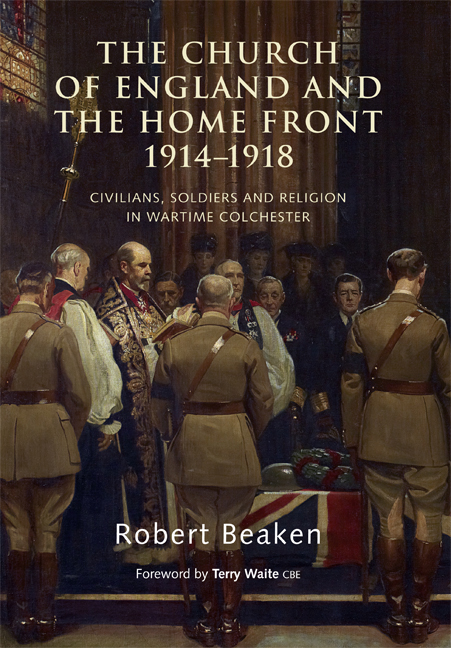 The Church of England and the Home Front, 1914-1918
The Church of England and the Home Front, 1914-1918 Book contents
- Frontmatter
- Dedication
- Contents
- List of Illustrations
- Foreword
- Author’s Acknowledgements
- 1 The First World War – One Hundred Years On
- 2 Colchester
- 3 Wartime
- 4 The Clergy
- 5 The Laity
- 6 Prayer and Worship
- 7 The National Mission of Repentance and Hope
- 8 Thought and Attitudes
- 9 Armistice, Remembrance and Aftermath
- 10 The Church of England and the First World War
- Bibliography
- Index
7 - The National Mission of Repentance and Hope
Published online by Cambridge University Press: 11 May 2021
- Frontmatter
- Dedication
- Contents
- List of Illustrations
- Foreword
- Author’s Acknowledgements
- 1 The First World War – One Hundred Years On
- 2 Colchester
- 3 Wartime
- 4 The Clergy
- 5 The Laity
- 6 Prayer and Worship
- 7 The National Mission of Repentance and Hope
- 8 Thought and Attitudes
- 9 Armistice, Remembrance and Aftermath
- 10 The Church of England and the First World War
- Bibliography
- Index
Summary
In the autumn of 1916 – as the effects of conscription were starting to be felt in communities across Britain, and as the battle of the Somme was drawing to its bloody conclusion in France – the Church of England held a simultaneous mission across every diocese and parish in England, something it had never attempted before. The 1916 National Mission of Repentance and Hope, as it was officially known, was at times muddled, ambiguous and controversial. The national mission has received little serious attention from historians, who, when they have written about it, have often been largely critical or dismissive. As a priest who conducts parish missions, I approach the 1916 national mission from a slightly different angle to many other historical writers. A great deal of the criticism levelled at the mission was richly deserved, but its undoubted successes and achievements – perhaps because they were not immediately obvious – have often been unfairly overlooked. Not the least of these was the very fact that, at the height of the First World War, the Church of England collectively devoted much of its time, energy and money to an attempt to bring anew the message of the Gospel to the nation. In Colchester, there are grounds for concluding that the 1916 national mission was, at least, moderately successful.
The Origins of the 1916 National Mission of Repentance and Hope
Wartime Religious Revival, 1914–15
In the autumn of 1914, there was a noticeable increase in the number of people attending church services. This phenomenon was patchy, and varied a good deal across the country, but it was widely believed at the time that this was the beginning of a religious revival. Theodore Woods, the vicar of Bradford and bishop of Peterborough from 1916, wrote in October 1914: ‘I believe that the Church is about to have the chance of its life … The churches are crowded with worshippers, and people seem to be up against the realities in a way which three months ago would have seemed impossible.’
Something similar was observable in the army in 1914–15. The men who volunteered to join Kitchener's New Army did so for a variety of reasons: some went to escape from dull jobs, or to be with their pals who had joined up, or for three square meals a day.
- Type
- Chapter
- Information
- The Church of England and the Home Front, 1914-1918Civilians, Soldiers and Religion in Wartime Colchester, pp. 161 - 191Publisher: Boydell & BrewerPrint publication year: 2015


